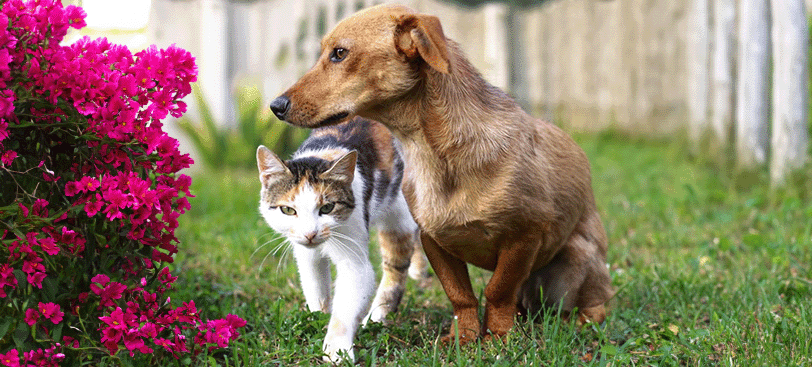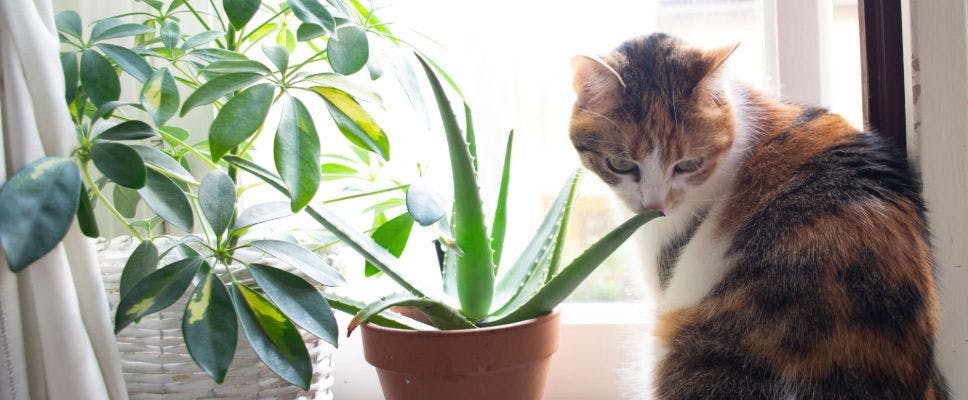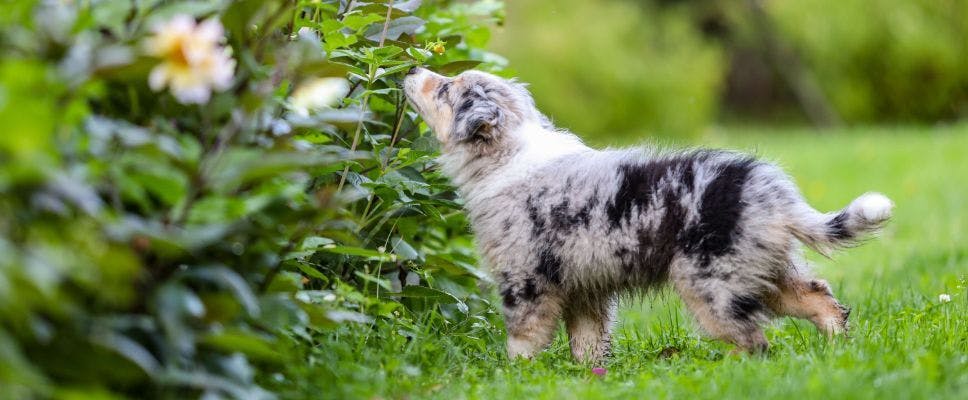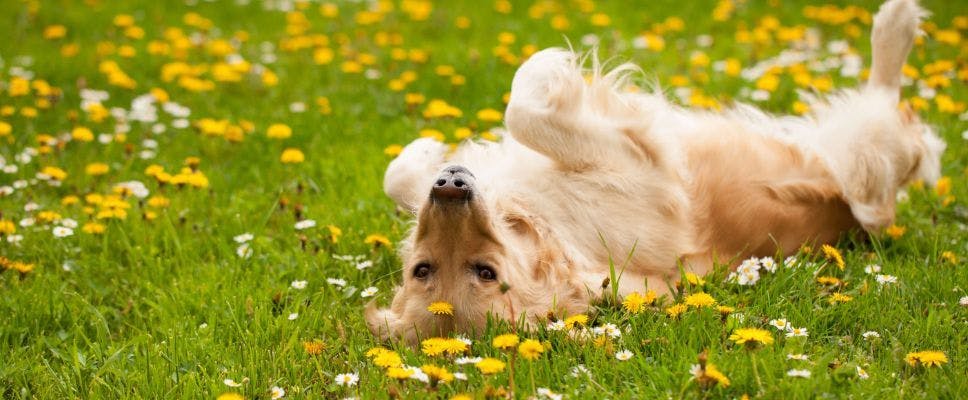
Indoor plants and flowers have grown in popularity in recent years. They’re an easy and affordable way to liven up a space and incorporate nature into our homes. Although they may look harmless, not all plants and flowers are safe for our four-legged family members to be around.
As pet owners, it’s our responsibility to keep our furry companions safe from harm, and while many plants are safe, some curious cats and dogs may be at risk of chewing on or ingesting plants that are poisonous which can cause illness, irritation or, in serious cases, death.
Young or old, your dog and cat can be vulnerable, so it pays to check whether your household plant or bouquet of flowers is safe.
List of poisonous plants for dogs and cats

There are many varieties of common household and garden plants that may pose a risk to your pet. The list below lists just some of the plants that may cause harm to your cat or dog:
- Aglaonema
- Aloe Vera
- Amaryllis
- Arrowhead Vine
- Azaleas
- Bird of Paradise
- Cherries
- Daffodil
- Daphne
- Dracaena Deremensis
- Dracaena Fragrans
- Dracaena Marginata
- Iris
- Jasmine
- Lily of the valley
- Mayapple
- Mistletoe
- Monkshood
- Moonseed
- Narcissus
- Nightshade
- Oak tree
- Rhododendrons
- Rhubarb
- Tulip
- Wisteria
- Yew
You can see a full list of plants harmful to dogs here, and for cats here.
List of non-poisonous plants for dogs and cats

There are many varieties of plants and flowers that are not harmless to our furry friends and can help liven up your indoor or outdoor spaces! The plants listed below are just a few examples of some of the flora that won’t pose any risk to the wellbeing of your dog or cat:
- Gloxinia
- Impatiens
- African violets
- Baby tears
- Banana leaves
- Spider plants
- Bromeliad
- Venus Fly Trap
- Parlor/Areca palm
- Boston Fern
- Calathea Zebra
- Chinese Money Plant
- Friendship Plant
- Polka Dot Plant
- American Rubber Plant
- Cast Iron Plant
- Orchid
- Bird’s Nest Fern
- Peperomia
- Mosaic Plant
- Ponytail Palm
- Purple Waffle Plant
- Staghorn Fern
- Royal Velvet Plant
- Majesty Palm
- Roses
- Sunflowers
As different plants have different poisonous parts, and with some containing toxins in all parts of the plant, it’s best to avoid leaving any potentially lethal flora in the house, or planting them in our gardens, as we can’t always control what our pets may decide to snack on.
What if a dog or cat eats a poisonous plant?
Veterinary care shouldn’t be delayed in any circumstance, as several species of toxic plants can cause death, even with diligent treatment. Dr Natalia Li advises that, “it’s essential to provide as much information to your vet as accurately as possible, including the time of ingestion, the type of plant and the amount ingested”. This not only helps the vets to come up with the most suitable treatment plan for your pet, but also greatly increases the survival rate in some circumstances due to a timely administration of the correct medication and dosage.
Symptoms of dog or cats eating poisonous plants
If your dog or cat has ingested or encountered a poisonous plant or flower, you may notice one or more of the following symptoms:
- Reduced appetite
- Vomiting
- Stomach pain
- Diarrhoea
- Excessive or abnormal salivation
- Swelling around the head
- Laboured breathing and/or an increased or decreased heart rate
- Pale/yellow/excessively red gums
- Random bleeding
- Excessively dilated or constricted pupils
- Sudden blindness
- Hyperthermia
- General weakness
- Hyperexcitability
- Failure to urinate or blood in urine
- Muscle stiffness and pain
- Collapse or paralysis
- Tremors or seizure activity
- Hallucination
- Reduced appetite
- Vomiting
- Stomach pain
- Diarrhoea
- Excessive or abnormal salivation
- Swelling around the head
- Laboured breathing and/or an increased or decreased heart rate
- Pale/yellow/excessively red gums
- Random bleeding
- Excessively dilated or constricted pupils
- Sudden blindness
- Hyperthermia
- General weakness
- Hyperexcitability
- Failure to urinate or blood in urine
- Muscle stiffness and pain
- Collapse or paralysis
- Tremors or seizure activity
- Hallucination
Diagnosing and caring for your pet
Depending on the time of ingestion, inducing vomit may be all your pet needs if brought to a vet clinic within two hours of ingestion. If it’s suspected there has been any level of digestion of a toxic plant, activated charcoal will be prescribed orally to absorb any toxins along the alimentary tract.
If your pet is symptomatic, depending on how severe their symptoms are, they will likely be kept in the clinic for intensive care overnight, or possibly days. Your pet will be put on an IV drip to maintain their hydration levels, and potentially an IV glucose if they’re vomiting or don’t want to eat. Constant blood tests would be performed to monitor their progress of recovery, as well as the administration of necessary medication to counteract the effects of the toxicity.
For asymptomatic pets, close monitoring will be required as some toxicity symptoms may not show until a few days later. Your vet may decide to take daily blood tests to monitor the internal organ function of your pet.
Tips to preventing dogs and cats getting near plants

The best way to prevent your pets from encountering dangerous plants is simply not to have them around your home. The potential of your pet becoming seriously ill isn’t worth the risk, and there are many green alternatives for you to choose from that won’t pose a threat to your pet’s health.
Alternatively, Dr Li suggests, “you can always teach your pets not to go near any plants in the house or garden. Administering unfavourable scents or taste around plants may work as a counter conditioning technique,” however, this may also completely reverse the purpose of having a plant or flower.
If you must keep a potentially dangerous plant in your house, we’d recommend keeping it in a place where it can’t be reached by your pet, bearing in mind that most cats can jump up to high places. If your cat does show interest in any household plants or flowers, it’s best to remove them from the space altogether as a precaution.
We know how important the health and safety of your pet is. If you’re in need of easy, real-time advice, speak to one of our trusted vets, wherever you are, with our Petstock Vet Chat. It’s a convenient online service available seven days a week from 6am until midnight.
Petstock Vet
Always speak to your local vet for more advice and information. Or you can visit one of our Petstock VET clinics in your local area.
Learn More